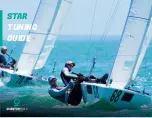
14
windlass to pay out a few feet of chain, secure the snubber line to a deck cleat, and then pay
out a few more feet of chain so that tension of the chain is transferred to the snubber line
rather than the windlass.
(2)
If there is line running from the water to the anchor rode (chain) locker rather than chain,
have the helmsperson bring the boat forward a few feet to provide some slack on the line and
secure the line to a deck cleat, while leaving it running through the chain guide at the bow.
Before raising the anchor
, start the engine. Use the hand-held remote as the boat moves toward the
anchor
on engine power
, pressing the ‘up’ control to take up slack line as you move forward, Do not
pull the line tight or pull the boat with the windlass. Have the helmsperson bring the boat forward
slowly to take up the slack. When you are directly over the anchor, raise the anchor up with the
windlass, giving the windlass short rests as you are raising the anchor. The windlass uses a large
amount of electrical power; so always operate the windlass with the engine running.
Once you are
directly above the anchor you can have the helmsperson put the engine in neutral, push the red button
on the throttle lever and then ease the throttle forward to bring the engine speed to about 1000 RPMs
to provide electric power to the windlass.
Slow the windlass to minimum speed as the anchor comes
out of the water.
The person tending the windlass should be in a position
to guide the anchor onto the
roller but not while the windless in running. Reconnect the blue keeper line to secure the anchor.
Coordinate the maneuver with the helmsperson to remain steady above the anchor as it is raised. As
the anchor rises, be careful not to allow it to swing against the hull.
If you put out line (rope) after exhausting the chain you can raise it wrapping it two or three times
around the hub on the left side of the windlass. Once the line is onboard, set the chain on the right
side in the cogged slot and bring it aboard.
If the windlass motor refuses to operate you may have overheated it and tripped the breaker. Wait a
few minutes for it to cool and then reset the breaker in the starboard aft cabin. You will find it hiding
in a nook behind the fire extinguisher that can be seen by sitting on the bunk and looking to towards
the engine and forward. If it still fails to operate, you can use operate it manually. Place the handle
that is in the anchor locker in the hole between the left hub and center of the windless and move it
back and forth using the ratchet mechanism.
A SPARE ANCHOR and rode is normally stowed in the aft port lazaret. Make sure that the rode is
securely attached to the boat before use.
Stern-to Anchoring
Some bays in British Columbia have steep under-water slopes. If you drop your anchor on one of
these slopes and the wind or current pulls the boat towards the center of the bay, your anchor may not
hold. For this reason, it is the custom in such bays to take a stern line ashore and tie it to a ring that
has been secured to a rock. In places where there are no rings you may be able to use the trunk of a
sturdy tree instead but only if the tree is on public property and there are no signs prohibiting this
practice. If it safe to do so and the depth allows, set your anchor from 150 to 250 feet from shore,
depending on depth and appropriate scope such that your stern will be about 40 to 90 feet from shore
when you back away from your anchor towards the shore. Have someone watch the depth and for
rocks as you back as your stern will probably be shallower than the depth indicated by the sounder
that is mounted amidships.




































